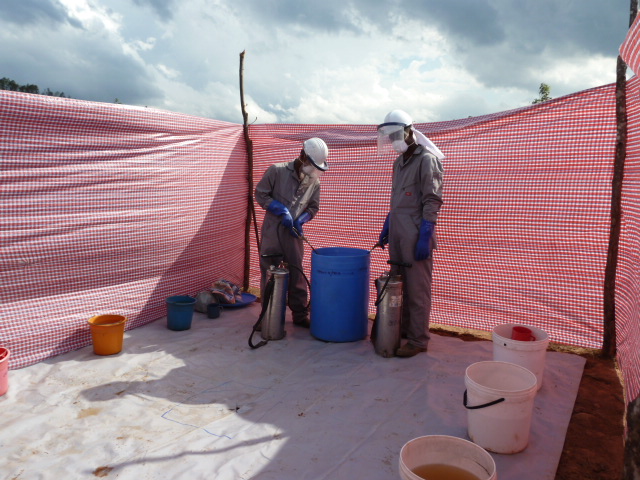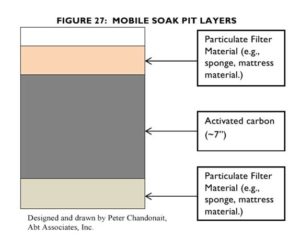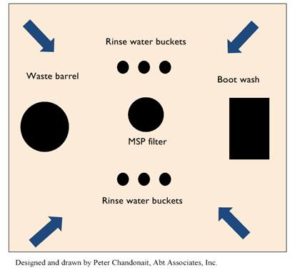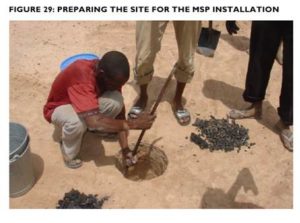images c/o Peter Chandonait
Peter Chandonait (MA ’03) is a Principal Scientist in the International Health Division at Abt Associates, a Cambridge-based consultancy and research firm that works in nearly 50 countries on health, social and environmental policy, climate change, and international development. Recently, his work has centered around the President’s Malaria Initiative (PMI) Africa Indoor Residual Spraying (AIRS) Project, which protects millions of people in Africa from malaria by spraying insecticide on the walls, ceilings, and other indoor resting places of mosquitoes that transmit malaria. In September 2017 he was the Grand Prize winner of USAID’s Innovation to Action Award for his work “creating and driving the adoption of a mobile soak pit (MSP), a type of water filter that has improved operational efficiency, produced cost savings, and extended the reach of the project, thereby improving USAID’s overall program impact.” We spoke over email:
Tell me about how you got involved with the PMI AIRS Project and how your idea for mobile soak pits came about.
In 2010, I was working for Abt’s International Economic Growth Division and did an environmental assessment for a malaria project in Uganda. The trip required a two-week field visit and preparation of a 100+ page document detailing the possible environmental impacts of a malaria prevention project and design of mitigation methods. My assessment was well-received by our client and elicited commendations from him to my company’s management. Shortly thereafter, when USAID’s President’s Malaria Initiative put a proposal out for bid for malaria prevention in 14 African countries, Abt included me as project environmental compliance manager in their winning bid.
During field visits to Zimbabwe and Madagascar, I observed our end-of-day cleanup procedures, which require rinsing pesticide residues from spray operators’ personal protective equipment, and from the inside and outside of spray equipment. This washing is normally performed on a sloped concrete or plastic-covered surface that directs the contaminated water into an in-ground installation called a soak pit. The soak pit consists of layers of gravel for filtering out large solids, and cooking charcoal, which absorbs insecticide from contaminated water as it passes through the filter. The carbon holds the insecticide in place (in the ground) for subsequent environmental degradation by hydrolysis, heat, and microbial action.
However, in these particular countries, small teams traveled significant distances to reach the targeted population, and had to retrace their journey to get back to an operational site for these cleanup operations. As this resulted in a short work day, I saw it was inefficient, and began to think about alternative solutions. Due to my background in water filtration, I leaned towards some kind of cartridge filter, but at first I could not figure out how to drive the water through the filter. It took me a little while to realize that if the filter was imbedded in the ground, gravity would do the work for me. After that, I began to experiment with different materials and configurations to get the most efficient filter. Using colored dyes as a surrogate for insecticide, I was able to determine appropriate materials, configurations, and dimensions for optimum absorption in the least amount of time. Thus, the mobile soak pit (MSP) was born.

Workers install an MSP, where wastewater contaminated with insecticides used to fight mosquitoes carrying malaria is filtered and discarded.
MSPs have already spread to 12 countries. Do you think they will become ubiquitous in mosquito-borne disease prevention worldwide? Why or why not?
In actuality, we are by far running the largest indoor residual spraying (IRS) program in the world, so the ability to expand the usage of the MSP in this context is limited. The fact that several African governments have adopted this technology for their own IRS programs speaks to the logic and efficiency of MSP use. Moreover, we have already started to use the MSP in Zika prevention in the Dominican Republic, and other Latin American and Caribbean countries may adopt it as well.
However, my vision is to transfer this technology to USAID’s agricultural projects. While they are not as advanced environmentally as the IRS program, agriculture uses larger amounts of pesticides in more countries without the proper safeguards for the safe disposal of contaminated wastewater. In addition, it is feasible to use this filter to remove a range of contaminants from drinking water, although the technical assistance requirements would be considerably higher.
I am hoping that the publicity of my award, as well as the contacts I made at the USAID Global Development Laboratory, will help me disseminate the MSP concept into new fields.
How did your experience at Tufts prepare you for this work? Anything you got out of UEP that has helped with your understanding of international environmental policy and planning?
I came into the UEP program with the perspective of a scientist and engineer, focusing on the technical aspects of accomplishing an objective. I did not have a very good holistic understanding of issues, including the cultural contexts, nor did I have a strong drive to maximize the impact of my skills to “make the world a better place”. Through my interactions with UEP and CEE staff, such as Jon Witten, Ken Geiser, and John Durant, I became more concerned with global and local problems. I started to consider how I could contribute to solutions, as well as gauge the impact of my work.
My thesis in Civil and Environmental Engineering, in which I designed and installed a water treatment system for a rural school in Guatemala, further broadened my perspective and ultimately played a role in landing my first internationally-focused professional position at Abt Associates. At first I worked on environmental issues in Latin America in connection with the Central American Free Trade Agreement, and on water and sanitation projects in Pakistan. But as described above, I soon was drafted into the Africa Indoor Residual Spraying Project full-time, as the Director of Environmental Compliance and Safety.
My work at Abt is in a dramatically different context than my previous industrial experience, but my studies at UEP helped me understand government policies (US and host country) and adapt to working within the government systems. I learned a great deal at UEP about change management, and this has helped me be successful while introducing and implementing new concepts and technology, especially in resource-poor environments.
The press release about the award says you developed the MSP design in your home laboratory. What else have you worked on there, and are there any upcoming projects you’d like to share?
I have a project for developing a solar powered drinking water filtration system on the back burner, but I have not had the time to develop it yet. I have installed and tested water filtrations that include lead removal and ultraviolet sterilization in my home, and given the recent controversy over lead in public water systems, and its potential effects on my young daughter, I’m glad that I at least got that far!



